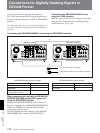
Chapter 8 Maintenance and Troubleshooting
136 Chapter 8 Maintenance and Troubleshooting
Input problems
Symptom Cause Remedy
Data is not superimposed on
the monitor screen.
The CHARACTER switch on the
subsidiary control panel is set to OFF.
Set the CHARACTER switch on the subsidiary
control panel to ON.
The monitor is not connected to the
VIDEO OUT 3 (SUPER) or SDI OUTPUT
3 (SUPER) connector of this unit.
Connect the monitor to the VIDEO OUT 3
(SUPER) or SDI OUTPUT 3 (SUPER) connector.
(You must make this connection to display any
type of text on the monitor.)
The image on the monitor
screen is too bright.
The 75 Ω termination switch for video
input on the monitor is in the OFF
position or a 75 Ω terminator is not fitted
to its video input connector.
Set the 75 Ω termination switch to ON or connect
a terminator.
The image on the monitor
screen is too dark.
In a video signal loop-through connection
of video monitors, 75 Ω termination
switches for video input on monitors
other than the loop-end monitor are in
the ON position.
Set the 75 Ω termination switches to OFF on all
monitors other than the loop-end monitor .
The image is too dark when
recording a composite video
signal.
Troubleshooting
Symptom Cause Remedy
It is not possible to record an
SDTI signal.
No SDTI signal is input to the unit.
a)
Connect an SDTI (QSDI) signal to the SDTI
(QSDI) INPUT connector.
a) In this state, an alarm message appears in the display section
and on the monitor screen.
Monitor problems
Audio problems
i.LINK interface problems
Symptom Cause Remedy
Turning the REC controls does
not change the audio input
levels.
The REC controls are pushed in. Pull out the REC controls.
Turning the PB controls does
not change the playback audio
output levels.
The PB controls are pushed in. Pull out the PB controls.
Symptom Cause Remedy
This unit cannot be recognized
or controlled by computer via
i.LINK interface.
Performance of i.LINK interface is not
guaranteed with all IEEE-1394 devices.
It is only guaranteed as a tape dubbing
facility between VTRs.
• Check the computer for connections and setup.
• Contact your computer hardware/software
manufacturer to check system requirements and
product compatibility.


















